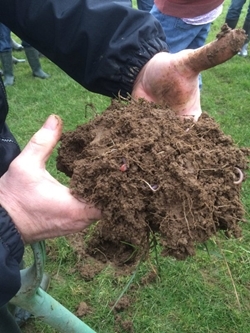 On the face of it, we should welcome the research published in Science that improved crop performance can be achieved in hard soils through gene modification (reported in Farming UK). Whilst soil compaction does restrict crop yields, the solution is more complex than to just adapt plant genetics. Soil health is in decline generally and compacted soils cause a number of environmental problems too.
On the face of it, we should welcome the research published in Science that improved crop performance can be achieved in hard soils through gene modification (reported in Farming UK). Whilst soil compaction does restrict crop yields, the solution is more complex than to just adapt plant genetics. Soil health is in decline generally and compacted soils cause a number of environmental problems too.
It is estimated that 40% of agricultural land is liable to compaction and that the costs of soil erosion due to reduced crop yields, reduced carbon storage, and impacts on drinking water run to £1.2bn per year in England and Wales alone.
Growing crops in compacted soils limits their ability to root effectively and take up nutrients and water. In winter, poor quality soils are more prone to waterlogging, and crops on them are more susceptible to pests and competition from some weeds. To address this, it is our view that it is important to invest in farming systems that promote good soil health where a combination of favourable structure, a good level of organic matter, and a healthy ecosystem of living organisms supports not only food production (crop yields) but also the carbon sequestration potential of soils and broader environmental goals such as water quality and aquatic biodiversity.
Soil washed from compacted fields gets into watercourses through surface run-off and field drains, resulting in water quality being compromised not only by the sediment but also by the nutrients and chemicals applied to the crop. Raised levels of nutrients and sediment in watercourses can also have consequences for biodiversity.
Sediment is a pollutant in its own right. High levels of sediment make watercourses cloudy, thereby affecting the light that enters the water ecosystem, and when it settles on the gravel bottom it clogs the gravel, reduces the availability of oxygen, and smothers fish eggs. Many aquatic invertebrates are filter feeders, and sediment can affect their feeding structures. In addition, silting in rivers and lakes can reduce water storage capacity in the landscape and disrupt river flow, with consequences for flooding.
Run-off from compacted fields can increase levels of nitrogen and phosphorus in particular, with the consequence of excessive growth of plant life – algal blooms, for example – which can disrupt in-water ecosystems. Other pollutants can also be carried on sediment into watercourses, such as pesticides residues.
Given the importance of our soil resource to food production and the impacts of its loss to other environmental problems, the GWCT has extensively researched solutions to the problems posed above through projects such as Water-Friendly Farming. Reduced or no-till farming, cover crops, tramline management, in-field wetlands, permeable dams and buffer strips have all been proven to contribute to resolving compaction and erosion. Importantly, they can be combined into farming systems, such as Conservation Agriculture, leading to greater environmental gains across the landscape.
So whilst understanding how roots penetrate hard soils could aid the development of crops that are more resilient to soil compaction, the real focus should be on the causes of the soil compaction and its resolution, not only to maintain crop yields but also to maintain and improve the most vital natural asset we have for food production, soil, and to manage it in a way that is environmentally sustainable.
Read the GWCT’s The Soil and Water Balance: The Science Behind Soil Friendly Farming for more information.